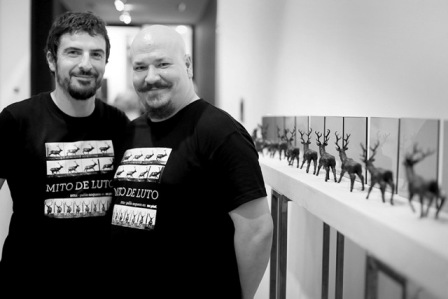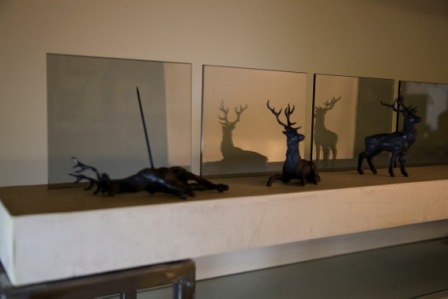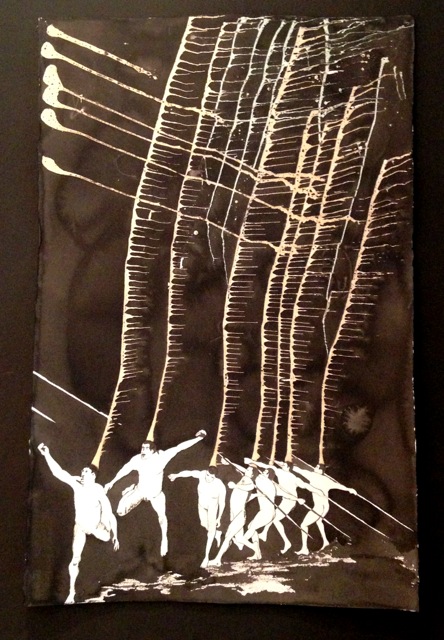Valencia (and half French) artist Pablo Noguera’s latest exhibition deals with the refugee crisis in the Mediterranean, drawing on sources such as Homer’s Odyssey to reflect upon this critical situation.
From the 4th October until 20th December the exhibition can be seen at Calle Moro Zeit, 6, in the medieval district of Valencia.
Pablo Noguera is one of Valencia’s most international artist, having exhibited in Paris, in the United Nations Palace at Geneva, in Maguncia and Karlsruhe (Germany), Helwan and Cairo (Egypt) and in Salzburg (Austria).
MYTH SEQUENCES (Exhibited in Mister Pink July 2014)

Sequences of myth: the transformation of reality into story and from this into myth is the essence of our cultural tradition, that which has built our identity.
Unlike other animals, humans are able to anticipate the future, hence the power over the rest and hence also our infinite drama, because the end is known in advance.
Culture, and its conversion into an object, action or story, is the ability to stop a moment and the power to make it everlasting, while it moulds he who does so and those who contemplate it, in a sort of self construction and bypass, also the social imaginary. Learning can not be separated from the creative experience, and vice versa.
Coming from an area centred on the pictorial and drawing, Pablo Noguera has arrived at a place where it has been necessary to combine materials and dimensions; leave the flat surface and the boundaries defined by abstraction to cope with the scaled world mimesis.
This journey is not without uncertainties, of dodging traps and successful achievements, like life itself. Hence the artist has needed to face this new world first facing a myth.
The myth of Cyparissus narrates the drama of the death, by mistake, of the favourite stag of Cyparissus who, on becoming aware of his mistake and his mourning without end, requests that the god Apollo makes him a tree.
Pablo Noguera has thoroughly analysed this myth told in Ovid’s Metamorphoses to turn it into a sequence.
After this message, the combination of materials takes form in installations, photography, video, ink and acrylic on paper. In turn, the installations use fiberglass, bronze, paper, cypress wood in blocks and foils, glass, white marble from Thasos, the antlers of a deer … elements arranged as a necessary hybridization.
If a sequence refers to the “disposition or series of certain things following each other” it seems appropriate here to refer to his way of working with this definition; each work provides information and repeats a face of a polyhedron figuratively.
A scale figure of Cyparissus mounted on the deer; the cypress Javelin on a bed of a stain of lead; the deer killed sequentially; deer antlers and skull on which the text of the myth is inscribed; the cypress carved in marble fitted into a symbolic landscape; a living cypress suspended from the ceiling; it’s fruit photographed; a catalogue of trees; a dramatization of the myth recorded and presented in a video loop … are nearly correlative parts of this sequence of enormous complexity.
Art uses here all its best arms, without revealing any. Pablo Noguera’s passage to face the world through his culture of coded images, and materials make up his formal diversity, is a definite step -and possibly without turning back- to the consciousness of the limits, but also to panoramic knowledge of its possibilities. The beginning of a journey based on a myth that will become, sooner or later, a series of encounters with reality itself.
Everything may have started like the sea; without name or horizon, with a bluish green colour changing and mirror-like with its reflections and shining, something like this water. After visiting Pablo at his studio, I have come to the beach looking for the calm of summer at the seashore and from the water to these notes about his papers and I’m remembering Paul Klee at the Tunisian beaches that spring a century before –this same Mediterranean sea down there in the North of Africa- where he spent the mornings in his swimsuit, feeling troubled, painting watercolours and swimming in the sea alternately. Always the water and this light.
I’ve been thinking these last few days, gazing at the comings and goings of the waves on the shore of this beach and I find it the best way observe the change, an about turn that has come upon Pablo’s painting since the deciphering series, initiated in 2012. Something like that is what seems to have occurred in his works when leaving aside (but not far, I’d say, in some way, looking in a different direction) the materiality of the Abstract Expressionism led by Pollock -see Pablo’s canvases such as Razón 02 (2008), Sobre la mente humana 125 (2008) or the series Idéal and Spleen- to spread out on paper glazings of watercolour as if “this is possible”, to the other side of the same bridge, which translates here as a revision of the quantity of paint left on the painting and a consideration -more than a technical adjustment- on the light; nimble, illuminated and liquid.
Leaving aside the monumentality of Pont de mestissatge (2009) – that free standing 16 metre long canvas that was exhibited, spread out in his exhibition in the cloister of the Algemesí Museum- and of other large format works, to concentrate in smaller pieces of paper where the white background allows the highlighting of abstract landscapes, where vigorous brush strokes appear, perhaps intrepid, necessary I would say, maintaining the drippings and streams of the liquid watercolour on a mask that will later reveal grids of an organic geometry which are the paper’s whiteness itself.
Is white a void here? He has an answer for that: “Decipherings” is a watercolour series where the original blot is the mask that is created from the void. And starting from the void, I seek to maintain it. From the vastness of the white paper, from the space of all possiblities, I take a precious and vital time in my integration with that void”.
Therefore, the watercolour’s wash and glazings superimpose themselves and are wrapped up in a kind of grid, of natural net, tracking its slits, gaps and nooks, almost reminding us of the result of the effects of transparency in the pieces of a stained glass window. We find ourselves before abstract landscapes, mental architectures, something purely pictorial… Landscapes made only by painting and its process: the blot, the mask, the line.
But also, on the other hand, there remains as a measure of an established order an attachment for central compositions that reminds me now of the works of Adolph Gottlieb, of Jean Fautrier, not at all the caprices of the swift artist Georges Mathieu, but much more something like what Paul Klee might have painted in Tunisia after that trip in the spring of 1914… It might be this sea, this light.
It might be the light contained in Pablo’s papers, the one that is glimpsed as if through the slits of the mask, the one of the transparencies or certain flashes of colour that grab our attention (see the work called 2012 + C-23), It might be the final appearance as a Cartography, the vegetal layout of the shapes or the remembrance of that same outline of the skins, its organic geometry… It might be that central grid in the composition that seems to float on the paper, even as it overflows downwards, over the painting _being water- attracted finally by physical gravity.
It comes to mind in my book-less retirement, what Michel Tapié described at the beginning of the fifties as shapelessness in painting: a reference to anti-geometry, to anti-naturalism and to the non-figurative formal concerns of a group of painters who outlined and defended spontaneity, imprecise shapes and the irrational.
And that is where these works by Pablo seep in, in my memories, here at the beach, with his ranges that extend to blue, to green to a watercolour grey that is deposited on and in between the fibres of the papers.
Shapelessness is not without shape, it’s something else. But what?
There I would have to try and decipher what Pablo’s thoughts are -that is what I am thinking now upon the shore- when he paints on these papers. Maybe he thought about the sea, with that progressive geometry which subtly argues the arrival of the waves on the beach, or he may think about how the breeze sways the vegetation and the bodies, like the water. And as he thinks that, I imagine, he manipulates it: a robust mass of coloured water.
Ricardo Forriols
Art critic
Universitat Politècnica de València




